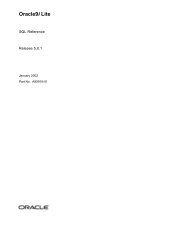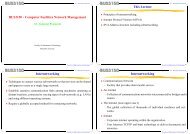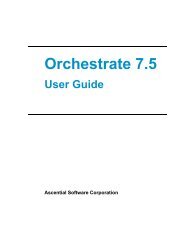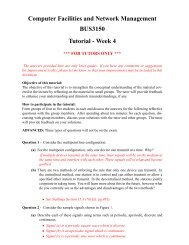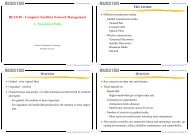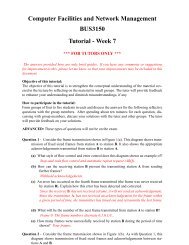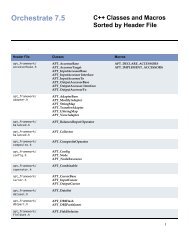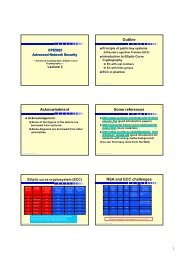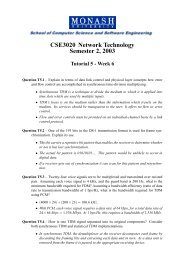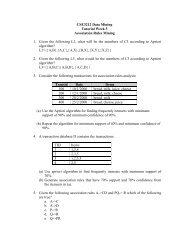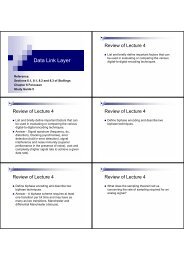Internet Protocol Contd. - Pravin Shetty > Resume
Internet Protocol Contd. - Pravin Shetty > Resume
Internet Protocol Contd. - Pravin Shetty > Resume
Create successful ePaper yourself
Turn your PDF publications into a flip-book with our unique Google optimized e-Paper software.
Learning Objectives<br />
<strong>Internet</strong> <strong>Protocol</strong><br />
Reference<br />
Sections 18.1, 18.2 and 18.4 Stallings<br />
Study Guide 10<br />
! describe the basic functions of networking<br />
protocols;<br />
! understand the principles of internetworking;<br />
! use and understand terms related to<br />
internetworking; and<br />
! explain the network addressing and packet<br />
structures of the <strong>Internet</strong> <strong>Protocol</strong>.<br />
<strong>Protocol</strong> Functions<br />
! Small set of functions that form basis of all<br />
protocols<br />
" Encapsulation<br />
" Fragmentation and reassembly<br />
" Connection control<br />
" Ordered delivery<br />
" Flow control<br />
" Error control<br />
" Addressing<br />
" Multiplexing<br />
" Transmission services<br />
Basic <strong>Protocol</strong> Functions<br />
! Not all protocols have all functions; this would involve a<br />
significant duplication of effort<br />
! However, there are many instances where the same<br />
type of function are present in protocols at different<br />
levels<br />
! <strong>Protocol</strong> functions can be categorised as follows:<br />
# Encapsulation<br />
! For all protocols, data are transferred in blocks, called protocol data<br />
units (PDUs)<br />
Basic <strong>Protocol</strong> Functions <strong>Contd</strong>.<br />
! Each PDU contains not only data but also control information<br />
! The addition of control information to data is referred to as<br />
encapsulation<br />
# Fragmentation and Reassembly<br />
! At the application level, we refer to a logical unit of data transfer as<br />
a message<br />
! Whether the application entity sends data in messages or in a<br />
continuous stream, lower level protocols may need to break the<br />
data up into blocks of some smaller bounded size<br />
# This process is called fragmentation<br />
Basic <strong>Protocol</strong> Functions <strong>Contd</strong>.<br />
! Some typical reasons for fragmentation are:<br />
# The communication network may only accept blocks of data up to a<br />
certain size<br />
$ An ATM network is limited to blocks of 53 octets and Ethernet<br />
imposes a maximum size of 1526 octets<br />
# Error control may be more efficient with a smaller PDU size<br />
$ Fewer bits need to be retransmitted when suffers from an error<br />
# More equitable access to shared transmission facilities, with shorter<br />
delay, can be provided<br />
# A smaller PDU size mean the receiving entities can allocate smaller<br />
buffers
Basic <strong>Protocol</strong> Functions <strong>Contd</strong>.<br />
Basic <strong>Protocol</strong> Functions <strong>Contd</strong>.<br />
! The arguments against fragmentation – to make larger PDUs- are:<br />
# Each PDU contains a certain amount of control information; smaller the<br />
blocks, the greater the percentage of overhead<br />
# PDU arrival may generate an interrupt that must be serviced; smaller<br />
blocks results in more interrupts<br />
# More time is spent processing smaller, more numerous, PDUs<br />
! The counterpart of fragmentation is reassembly<br />
# The segmented data must be reassembled to messages appropriate o<br />
the application level, eventually<br />
# If the PDUs arrive out of order, the task is complicated<br />
Basic <strong>Protocol</strong> Functions <strong>Contd</strong>.<br />
# Connection Control<br />
Basic <strong>Protocol</strong> Functions <strong>Contd</strong>.<br />
! Connection-oriented data transfer is to be preferred (even required) if<br />
stations anticipate a lengthy exchange of data and/or certain details of<br />
their protocol must be worked out dynamically<br />
! In the above situations, a logical association, or connection, is<br />
established between the entities<br />
! The three phases occur with respect to a connection are:<br />
# Connection establishment<br />
# Data transfer<br />
# Connection termination<br />
Basic <strong>Protocol</strong> Functions <strong>Contd</strong>.<br />
! A Key characteristic of many connection-oriented data transfer<br />
protocols is that sequencing is used<br />
# Each side sequentially numbers the PDUs that it sends to the other<br />
side<br />
# As each side remembers that it is engaged in a logical connection, it<br />
can keep track of both outgoing numbers, which it generates, and<br />
incoming numbers, which are generated by the other side<br />
$ One can essentially define a connection-oriented data transfer as<br />
one in which both sides number PDUs and keep track of both<br />
incoming and outgoing numbers<br />
# Sequencing supports 3 main functions:<br />
$ Ordered delivery, flow control, and error control<br />
Basic <strong>Protocol</strong> Functions <strong>Contd</strong>.<br />
# Ordered Delivery<br />
! If two communicating entities are in different hosts connected by a<br />
network, there is a risk that PDUs will not arrive in the order in which<br />
they were sent<br />
# This is because they may traverse different paths through the network<br />
! In connection-oriented protocols, it is generally required that PDU<br />
order be maintained<br />
! If each PDU is given a unique number, and numbers are assigned<br />
sequentially, then it is a logically simple task for the receiving entity<br />
to reorder PDUs on the basis of the sequence number
Basic <strong>Protocol</strong> Functions <strong>Contd</strong>.<br />
# Flow Control<br />
# A problem with the above scheme is that, with a finite sequence<br />
number field, sequence numbers repeat (modulo some maximum<br />
number)<br />
# The maximum sequence number must be greater than the maximum<br />
number of PDUs that could be outstanding at any time<br />
! A function performed by a receiving entity to limit the amount or rate<br />
of data that is sent by a transmitting entity<br />
! Flow control is a good example of a function that must be<br />
implemented in several protocols<br />
# The network will need to exercise flow control over X via network<br />
access protocol, to enforce network traffic control<br />
Basic <strong>Protocol</strong> Functions <strong>Contd</strong>.<br />
# At the same time, Y’s network access module has only limited<br />
buffer space and needs to exercise flow control over X’s<br />
network access module via the transport protocol<br />
# Finally, even though Y’s network access module can control its<br />
data flow, Y’s application may be vulnerable to overflow<br />
# Error Control<br />
$ The application may hung up waiting for disk access<br />
$ Thus flow control is also needed over the applicationoriented<br />
protocol<br />
! Error control techniques are needed to guard against loss or<br />
damage of data and control information<br />
Basic <strong>Protocol</strong> Functions <strong>Contd</strong>.<br />
Basic <strong>Protocol</strong> Functions <strong>Contd</strong>.<br />
! As with flow control, error control is a function that must be<br />
performed at various layers of protocol<br />
# The network access protocol should include error control to assure that<br />
data are successfully exchanged between station and network<br />
# However, a packet of data may be lost inside the network, and the<br />
transport protocol should be able to recover from this loss<br />
# Addressing<br />
! The concept of addressing in a communications architecture is a<br />
complex one and covers the following issues:<br />
# Addressing level<br />
$ Refers to the level in the communications architecture at which an<br />
entity is named<br />
Basic <strong>Protocol</strong> Functions <strong>Contd</strong>.<br />
$ Typically, a unique address is associated with each end system<br />
(e.g., workstation or server) and each intermediate system (e.g.,<br />
router)<br />
$ Such an address, in general, is a network-level address<br />
$ In TCP/IP architecture, this is known as an IP address, or simply<br />
an internet address<br />
$ In OSI architecture, this is referred to as a network service access<br />
point (NSAP)<br />
$ The network-level address is used to route a PDU through a<br />
network or networks to a system indicated by a network-level<br />
address in the PDU<br />
$ Once data arrive at a destination system, they must be routed to<br />
some process or application in a system<br />
Basic <strong>Protocol</strong> Functions <strong>Contd</strong>.<br />
$ Typically, a system will support multiple applications and an<br />
application may support multiple users<br />
$ Each application and, perhaps, each concurrent user of an<br />
application, is assigned a unique identifier, referred to as a port in<br />
the TCP/IP architecture and as a service access point (SAP) in the<br />
OSI architecture<br />
# Addressing Scope<br />
$ The internet address or NSAP address referred to previously is a<br />
global address<br />
$ A global address identifies a unique system (global nonambiguity)<br />
$ It is possible at any global address to identify any other global<br />
address, in any system, by means of the global address of the other<br />
system (global applicability)
Basic <strong>Protocol</strong> Functions <strong>Contd</strong>.<br />
$ Because a global address is unique and globally applicable, it<br />
enables an internet to route data from any system attached to any<br />
network to any other system attached to any other network<br />
$ Each network must maintain a unique address for each device<br />
interface on the network<br />
$ Examples are MAC address on an IEE 802 network and an ATM<br />
host address<br />
$ This address enables the network to route data units (e.g., MAC<br />
frames, ATM cells) through the network and deliver them to the<br />
intended attached system<br />
$ Such an address is referred to as a network attachment point<br />
address<br />
Basic <strong>Protocol</strong> Functions <strong>Contd</strong>.<br />
$ The issue of addressing scope is generally only relevant for<br />
network-level addresses<br />
$ A port or SAP above the network level is unique within a given<br />
system but need not be globally unique<br />
# Connection identifiers<br />
$ The concept of connection identifiers comes into play when we<br />
consider connection-oriented data transfer (e.g., virtual circuit)<br />
rather than connectionless data transfer<br />
$ For connectionless data transfer, a global identifier is used with<br />
each data transmission<br />
$ For connection-oriented transfer, it is sometimes desirable to use<br />
only a connection identifier during data transfer phase<br />
Basic <strong>Protocol</strong> Functions <strong>Contd</strong>.<br />
# Multiplexing<br />
# Addressing mode<br />
$ Most commonly, an address refers to a single system or port; in<br />
this case it is referred to a s an individual or unicast address<br />
$ It is also possible for an address to refer to more than one entity or<br />
port; such an address identifies multiple simultaneous recipients<br />
for data<br />
$ An address for multiple recipients may be broadcast, intended for<br />
all entities within a domain, or multicast, intended for a specific<br />
subset of entities<br />
! One form of multiplexing is supported by means of multiple<br />
connections into a single system<br />
Basic <strong>Protocol</strong> Functions <strong>Contd</strong>.<br />
# For example, there can be multiple data link connections terminating in<br />
a single end system<br />
$ We can say that these data link connections are multiplexed over<br />
the single physical interface between the end system and the<br />
network<br />
! Multiplexing can also be accomplished via port names, which also<br />
permit multiple simultaneous connections<br />
# For example, there can be multiple TCP connections terminating in a<br />
given system, each connection supporting a different pair of ports<br />
! Multiplexing is used in another context as well, namely, mapping of<br />
connections from one level to another<br />
Basic <strong>Protocol</strong> Functions <strong>Contd</strong>.<br />
# In a network, for each process to process connection established at the<br />
higher level, a data link connection could be created at the network<br />
access level<br />
$ This is one-to-one relationship, but need not be so.<br />
# Multiplexing can be used in on of two directions<br />
$ Upward multiplexing, or inward multiplexing, occurs when multiple<br />
higher-level connections are multiplexed on, or share, a single<br />
lower-level connection<br />
$ Downward multiplexing, or splitting, means that a single higherlevel<br />
connection is built on top of multiple lower-level connections,<br />
the traffic on the higher connection being divided among the<br />
various lower connections<br />
Basic <strong>Protocol</strong> Functions <strong>Contd</strong>.<br />
# Transmission Service<br />
! A protocol may provide a variety of additional services to the entities<br />
that use it<br />
! Three common examples are:<br />
# Priority<br />
$ Certain messages, such as control messages, may need to get<br />
through to the destination entity with minimum delay<br />
$ Thus, priority could be assigned on a message basis, or on a<br />
connection basis<br />
# Quality of service<br />
$ Certain classes of data may require a minimum throughput or a<br />
maximum delay threshold
Basic <strong>Protocol</strong> Functions <strong>Contd</strong>.<br />
# Security<br />
$ Security mechanisms, restricting access, may be invoked<br />
! All of these services depends on the underlying<br />
transmission system and any intervening lower-level<br />
entities<br />
Principles of <strong>Internet</strong>working<br />
! Packet-switching and packet-broadcasting networks grew<br />
out of a need to allow the computer user to have access to<br />
resources beyond that available in a single system<br />
# Resources of a single network are often inadequate to meet user’s<br />
needs<br />
! As the networks that might be interest exhibit so many<br />
differences, it is impractical to consider merging them into<br />
a single network<br />
# Rather, what is needed is the ability to interconnect various<br />
networks so that any 2 stations on any of the constituent networks<br />
can communicate<br />
Principles of <strong>Internet</strong>working <strong>Contd</strong>.<br />
! An interconnected set of networks, from a user’s point of<br />
view, may appear simply a large network<br />
# However, if each of the constituent networks retain its identity and<br />
special mechanisms are for communicating across multiple networks,<br />
then the entire configuration is often referred to as an internet<br />
! Each constituent network in an internet supports<br />
communication among the devices attached to the network<br />
# These devices are referred to as end systems (ESs)<br />
Principles of <strong>Internet</strong>working <strong>Contd</strong>.<br />
! In addition, networks are connected by devices referred to in<br />
the ISO documents as intermediate nodes (ISs)<br />
# ISs provide a communications path and perform the necessary relaying<br />
and routing functions so that data can be exchanged between devices<br />
attached to different networks in the internet<br />
# Two types of ISs of particular interest are bridges and routers<br />
! A bridge operates at layer 2 of the OSI 7 layer architecture and acts as a<br />
relay of frames between similar networks<br />
! A router operates at layer 3 of the OSI architecture and routes packets<br />
between potentially different networks<br />
Principles of <strong>Internet</strong>working <strong>Contd</strong>.<br />
! The overall requirements for an internetworking facility are:<br />
# Provide a link between networks<br />
! At minimum, a physical and link control connection is needed<br />
# Provide for routing and delivery of data between processes on<br />
different networks<br />
# Provide an accounting service that keeps track of the use of various<br />
networks and routers and maintains status information<br />
# Provide the services just listed in such a way as not to require<br />
modifications to the networking architecture of any of the constituent<br />
networks<br />
Principles of <strong>Internet</strong>working <strong>Contd</strong>.<br />
! This means that the internetworking facility must accommodate a<br />
number of differences among networks:<br />
# Different addressing schemes<br />
$ The networks may use different endpoint names and address and directory<br />
maintenance schemes<br />
$ Some form of global network addressing must be provided, as well as a<br />
directory service<br />
# Different maximum packet size<br />
$ Packets from one network may have to be broken up into smaller pieces for<br />
another; this process is referred to as fragmentation<br />
# Different network access mechanisms<br />
$ The network access mechanism between station and network may be<br />
different for stations on different networks
Principles of <strong>Internet</strong>working <strong>Contd</strong>.<br />
Principles of <strong>Internet</strong>working <strong>Contd</strong>.<br />
# Different timeouts<br />
$ Typically, a connection-oriented transport service will await an<br />
acknowledgment until a timeout expires, at which it will retransmit<br />
its block of data<br />
$ In general, longer times are required for successful delivery across<br />
multiple networks<br />
$ <strong>Internet</strong>work timing procedures must allow successful<br />
transmission that avoids unnecessary retransmissions<br />
# Error recovery<br />
$ Network procedures may provide anything from no error recovery<br />
up to reliable end-to-end (within the network) service<br />
$ The internetwork service should not depend on nor be interfered<br />
with by nature of the individual network’s error recovery capability<br />
# Status reporting<br />
$ Different networks report status and performance differently<br />
$ It must be possible for the internetworking facility to provide such<br />
information on internetworking activity to interested and authorised<br />
processes<br />
# Routing techniques<br />
$ <strong>Internet</strong>work routing may depend on fault detection and<br />
congestion control techniques peculiar to each network<br />
$ The internetworking facility must be able to coordinate these to<br />
route data adaptively between stations on different networks<br />
Principles of <strong>Internet</strong>working <strong>Contd</strong>.<br />
# User access control<br />
$ Each network will have its own user access control technique<br />
$ These must be invoked by the internetwork facility as needed<br />
$ Further, a separate internetwork access control technique may be<br />
required<br />
# Connection, connectionless<br />
$ Individual networks may provide connection-oriented or<br />
connectionless service<br />
$ It may be desirable for the internetwork service not to depend on<br />
the nature of the connection service of the individual network<br />
Principles of <strong>Internet</strong>working <strong>Contd</strong>.<br />
! A key characteristic of an internet architecture is whether<br />
the mode of operation is connection oriented or<br />
connectionless<br />
# Connection-oriented operation<br />
! It is assumed that each network provides a connection-oriented<br />
form of service<br />
# That is, it is possible to establish a logical network connection between<br />
any two end systems attached to the same network<br />
! ISs are used to connect 2 or more networks<br />
# Each IS appears as an ES to each of the network to which it is<br />
attached<br />
Principles of <strong>Internet</strong>working <strong>Contd</strong>.<br />
! When ES A wishes to exchange data with ES B, a logical<br />
connection is set up between them<br />
# This connection consists of the concatenation of a sequence of logical<br />
connections across networks<br />
! The individual network logical connections are spliced together by<br />
ISs<br />
# Any traffic arriving at an IS on one logical connection is retransmitted<br />
on a second logical connection and vice versa<br />
! A connection oriented IS performs the following key functions<br />
# Relaying<br />
$ Data units arriving from one network via the network layer protocol<br />
are relayed (retransmitted) on another network<br />
Principles of <strong>Internet</strong>working <strong>Contd</strong>.<br />
# Routing<br />
$ When an end-to-end logical connection consisting of a sequence logical<br />
connections, is to be set up, each IS in the sequence must make a routing<br />
decision that determines the next hop in the sequence<br />
! Thus, at layer 3, a relaying operation is performed<br />
# It is assumed that all of the end systems share common protocols at layer 4<br />
and above for successful end-to-end communication<br />
# Connectionless Operation<br />
! Connectionless-mode operation corresponds to the datagram mechanism<br />
of a packet-switching network<br />
! Each network protocol data unit is treated independently and routed from<br />
source ES to destination ES through a series of routers and networks
Principles of <strong>Internet</strong>working <strong>Contd</strong>.<br />
! For each data unit transmitted by A, A makes a decision as to which<br />
router should receive the data unit<br />
! The data unit hops across the internet from one router to the next<br />
until it reaches the destination network<br />
# At each router a routing decision is made (independently for each data<br />
unit) concerning the next hop<br />
$ Thus, different data units may travel different routes between<br />
source and destination ES<br />
! All Ess and routers share a common network-layer protocol known<br />
generally as the internet protocol<br />
! An <strong>Internet</strong> <strong>Protocol</strong> (IP) was initially developed for the DARPA<br />
internet project and published as RFC 791 and has become an<br />
<strong>Internet</strong> Standard<br />
Connectionless <strong>Internet</strong>working<br />
! In this section we refer specifically to the <strong>Internet</strong><br />
Standard IP, but it applies any connectionless <strong>Internet</strong><br />
<strong>Protocol</strong>, such as IPv6<br />
! IP provides connectionless, or datagram, service<br />
between end systems<br />
! The advantages of this approach are:<br />
# Connectionless internet facility is flexible<br />
! It can deal with a variety of networks, some of which are themselves<br />
connectionless<br />
! In essence, IP requires very little from the constituent networks<br />
Connectionless <strong>Internet</strong>working <strong>Contd</strong>.<br />
# A connectionless internet service can be made highly robust<br />
Connectionless<br />
<strong>Internet</strong>working<br />
<strong>Contd</strong>.<br />
! This is basically the same argument made for a datagram network<br />
service versus a virtual circuit service<br />
# A connectionless internet service is best for connectionless<br />
transport protocols, as it does not impose unnecessary overhead<br />
Connectionless <strong>Internet</strong>working <strong>Contd</strong>.<br />
! The figure in the previous slide depicts a typical example<br />
using IP, in which two LANs are interconnected by a frame<br />
relay WAN<br />
! End System A has a datagram to transmit to end system B<br />
# The datagram includes the internet address of B<br />
! The IP module in A recognises that the destination B is on<br />
another network<br />
# So the first step is to send the data to a router, in this case router X<br />
Connectionless <strong>Internet</strong>working <strong>Contd</strong>.<br />
! To send data to router X, IP passes the datagram down to<br />
the next lower layer ( in this case LLC) with instruction to<br />
send it to router X<br />
! LLC in turn passes this information down to MAC layer,<br />
which inserts the MAC-level address of router X into the<br />
MAC header<br />
! When the packet reaches router X, the router removes MAC<br />
and LLC fields and analyse the IP header to determine the<br />
ultimate destination of the data – in this case B
Connectionless <strong>Internet</strong>working <strong>Contd</strong>.<br />
! The router must now make a routing decision; there are<br />
3 possibilities<br />
# The destination station B is connected directly to one of the<br />
networks to which the router is attached<br />
! If so, the router sends the datagram directly to the destination<br />
# To reach the destination, one or more additional routers must be<br />
traversed<br />
! If so, a routing decision must be made: to which router the datagram<br />
must be sent?<br />
Connectionless <strong>Internet</strong>working <strong>Contd</strong>.<br />
! In both above cases, the IP module in the router sends the<br />
datagram down to the next lower layer with the destination network<br />
address<br />
# The router does not know the destination address<br />
! Router returns an error message to the source of the datagram<br />
! In the above example, the data must pass through router<br />
Y before reaching the destination<br />
# So the router X constructs a new frame by appending a frame<br />
relay header and trailer to the IP data unit<br />
# The frame relay header indicates a logical connection to router Y<br />
Connectionless <strong>Internet</strong>working <strong>Contd</strong>.<br />
Connectionless <strong>Internet</strong>working <strong>Contd</strong>.<br />
! When the frame arrives at router Y, the frame header<br />
and the trailer are stripped off<br />
! At each router, before the data can be forwarded, the<br />
router may need to fragment the data unit<br />
# The router determines that this IP data unit is destined for B,<br />
which is connected directly to a network to which this router is<br />
attached<br />
# The router therefore creates a frame with layer-2 destination<br />
address of B and sends it out onto LAN 2<br />
! The data finally arrive at B, where the LAN and IP<br />
headers can be stripped off<br />
# This is done to accommodate a smaller maximum packet size<br />
limitation on the outgoing network<br />
! The data units split into two or more fragments, each of<br />
which becomes an independent IP data unit<br />
! Each new data unit is wrapped in a lower-layer packet<br />
and queued for transmission<br />
Connectionless <strong>Internet</strong>working <strong>Contd</strong>.<br />
! The process described above continues through as<br />
many routers as it takes for the data unit to reach its<br />
destination<br />
! As with routers, the destination end systems recovers<br />
the IP data unit from its network wrapping<br />
! If fragmentation has occurred, the IP module in the<br />
destination end system buffers the incoming data until<br />
the entire original data field can be reassembled<br />
Connectionless <strong>Internet</strong>working <strong>Contd</strong>.<br />
! The service offered by IP is an unreliable one<br />
# That is, IP does not guarantee that all data will be delivered or<br />
that the data that are delivered will arrive in the proper order<br />
! It is the responsibility of the next higher layer (e.g., TCP) to recover<br />
from any errors that occur<br />
# This approach provides a great deal of flexibility<br />
! As the sequence of delivery is not guaranteed,<br />
successive data units can follow different paths through<br />
the internet<br />
# This allows the protocol to react to both congestion and failure in<br />
the internet by changing routes
<strong>Internet</strong> <strong>Protocol</strong><br />
! In this section, we will look at version 4 of IP, officially<br />
defined in RFC 791<br />
! Although it is intended that IPv4 will eventually be<br />
replaced by IPv6, it is currently the standard IP used in<br />
TCP/IP networks<br />
! As with any protocol standard, IP is specified in two<br />
parts:<br />
# The interface with higher layer (e.g., TCP), specifying the<br />
services that IP provides<br />
# The actual protocol format and mechanisms<br />
<strong>Internet</strong> <strong>Protocol</strong> <strong>Contd</strong>.<br />
! The services to be provided across adjacent protocol<br />
layers (e.g., IP and TCP) are expressed in terms pf<br />
primitives and parameters<br />
# A primitive specifies the function to be performed<br />
! The actual form of a primitive is implementation dependent<br />
! An example is a subroutine call<br />
# Parameters are used to pass data and control information<br />
! IP provides two service primitives at the interface to the<br />
interface to the next higher layer<br />
<strong>Internet</strong> <strong>Protocol</strong> <strong>Contd</strong>.<br />
<strong>Internet</strong> <strong>Protocol</strong> <strong>Contd</strong>.<br />
# The send primitive is used to request transmission of a data unit<br />
# The delivery primitive is used by IP to notify a user of the arrival<br />
of data unit<br />
! The parameters associated with the two primitives are as<br />
follows:<br />
# Source address<br />
# Destination address<br />
# <strong>Protocol</strong><br />
! Recipient protocol entity (such as TCP)<br />
# Type of service indicators<br />
! Used to specify the treatment of the data unit in its transmission<br />
through component networks<br />
# Identification<br />
! Used in combination with the source and destination addresses and<br />
user protocol to identify the data unit uniquely<br />
! This parameter is required for reassembly and error reporting<br />
# Don’t fragment identifier<br />
# Time to live<br />
<strong>Internet</strong> <strong>Protocol</strong> <strong>Contd</strong>.<br />
# Data length<br />
# Option data<br />
# Data<br />
! The identification, don’t fragment identifier, and time to<br />
live parameters are present in the Send primitive but not<br />
in the Deliver primitive<br />
# These 3 parameters provide instructions to IP that are not of<br />
concern to the recipient IP user<br />
<strong>Internet</strong> <strong>Protocol</strong> <strong>Contd</strong>.<br />
! The options parameter allows for future extensibility and<br />
inclusion of parameters that are usually not invoked<br />
# The currently defined options are<br />
! Security<br />
# Allow a security label to be attached to a datagram<br />
! Source routing<br />
# A sequenced list of router addresses that specifies the route to be<br />
followed<br />
! Route recording<br />
! Stream identification<br />
! Timestamping
<strong>Internet</strong> <strong>Protocol</strong> <strong>Contd</strong>.<br />
<strong>Internet</strong> <strong>Protocol</strong> <strong>Contd</strong>.<br />
! The protocol between IP entities is best described with<br />
reference to IP datagram format, shown in the previous<br />
slide<br />
! The fields are:<br />
# Version<br />
! Indicates version number, to allow evolution of the protocol; the<br />
value is 4<br />
# <strong>Internet</strong> Header Length (IHL)<br />
! The length of header in 32-bit words<br />
! The minimum value is 5, for minimum header length of 20 octets<br />
<strong>Internet</strong> <strong>Protocol</strong> <strong>Contd</strong>.<br />
<strong>Internet</strong> <strong>Protocol</strong> <strong>Contd</strong>.<br />
# Type of Service<br />
! Specifies reliability, precedence, delay, and throughput parameters<br />
! This field is rarely used<br />
# Total length<br />
! Total datagram length, in octets<br />
# Identification<br />
! A sequence number that, together with the source address,<br />
destination address, and user protocol, is intended to identify a<br />
datagram uniquely<br />
! Thus this number should be unique for the datagram’s source<br />
address, destination address, and user protocol for the time during<br />
which the datagram will remain in the internet<br />
# Flags<br />
! Only 2 bits are currently used<br />
# The more bit is used for fragmentation and reassembly<br />
# The Don’t fragment bit prohibits fragmentation when set<br />
# Fragment Offset<br />
! Indicates where in the original datagram this fragment belongs,<br />
measured in 64-bit units<br />
! This implies that fragments other than the last fragment must<br />
contain data field that is a multiple of 64 bits in length<br />
# Time to Live<br />
! Specifies how long, in seconds, a datagram is allowed to remain in<br />
the internet<br />
<strong>Internet</strong> <strong>Protocol</strong> <strong>Contd</strong>.<br />
# <strong>Protocol</strong><br />
! Indicates the next higher level protocol that is to receive the data<br />
field at the destination<br />
# Header Checksum<br />
! An error-detecting code applied to the header only<br />
! Because some header fields may change during transit, this is<br />
reverified and recalculated at each router<br />
# Source Address<br />
# Destination Address<br />
# Options<br />
<strong>Internet</strong> <strong>Protocol</strong> <strong>Contd</strong>.<br />
# Padding<br />
! Used to ensure that the datagram header is a multiple of 32 bits in<br />
length<br />
# Data<br />
! Must be an integer multiple of 8 bits in length<br />
! The maximum length of that datagram is 65,535 octets<br />
! The source and destination address fields in the IP header<br />
each contain a 32-bit global internet address, generally<br />
consisting of a network identifier and a host identifier<br />
! The address is coded to allow a variable allocation of bits<br />
to specify network and host, as shown in the next slide
<strong>Internet</strong> <strong>Protocol</strong> <strong>Contd</strong>.<br />
<strong>Internet</strong> <strong>Protocol</strong> <strong>Contd</strong>.<br />
! This encoding provides flexibility in assigning addresses to hosts<br />
and allows a mix of network sizes on an internet<br />
! The 3 principal network classes are best suited to the following<br />
conditions:<br />
# Class A<br />
! Few networks, each with many hosts<br />
# Class B<br />
! Medium number of networks, each with a medium number of hosts<br />
# Class C<br />
! Many networks, each with a few hosts<br />
<strong>Internet</strong> <strong>Protocol</strong> <strong>Contd</strong>.<br />
<strong>Internet</strong> <strong>Protocol</strong> <strong>Contd</strong>.<br />
! A mixture of classes is appropriate for an internetwork<br />
consisting of a few large networks, many small networks,<br />
plus some medium-sized networks<br />
! IP addresses are usually written in what is called dotted<br />
decimal notation, with a decimal number representing<br />
each of the octets of 32-bit address<br />
# For example, the IP address 11000000 11100100 00010001<br />
00111001 is written as 192.228.17.57<br />
! All class A network addresses begin with a binary 0<br />
! Network addresses with a first octet of 0 (00000000) and<br />
127 (01111111) are reserved<br />
# So there are 126 potential Class A network numbers, which have<br />
a first decimal number in the range 1 to 126<br />
! Class B network addresses begin with a binary 10<br />
# So the range of first decimal numbers in a class B address is<br />
128 to 191 (binary 10000000 to 10111111)<br />
# The 2 nd octet is also part of the Class B address<br />
! So there are 2 14 = 16,384 Class B addresses<br />
<strong>Internet</strong> <strong>Protocol</strong> <strong>Contd</strong>.<br />
! For Class addresses, the first decimal number ranges<br />
from 192 to 223 (11000000 to 11011111)<br />
! The total number of Class C addresses is 2 21 = 2,097,152<br />
Type of Service<br />
! Sending IP user may request types of<br />
service parameter<br />
# One or more services<br />
! Precedence<br />
! Reliability<br />
! Delay<br />
! Throughput<br />
! It can be used for routing priorities<br />
! Passed down to Network access layer
Type of Service…<br />
! Precedence – relative importance<br />
# 8 levels (higher number better preference)<br />
! Reliability<br />
# Normal or high : High - datagram should not be lost<br />
! Delay<br />
# Normal or low : low – minimum delay should be<br />
experienced<br />
! Throughput<br />
# Normal or high<br />
! If precedence selected and network supports<br />
this feature<br />
# Mapping to network level for this hop<br />
Subnets and Subnet Masks<br />
! Allow arbitrary complexity of internetworked LANs within<br />
organization<br />
! Insulate overall internet from growth of network numbers<br />
and routing complexity<br />
! Site looks to rest of internet like single network<br />
! Each LAN assigned subnet number<br />
! Host portion of address partitioned into subnet number<br />
and host number<br />
! Local routers route within subnetted network<br />
! Subnet mask indicates which bits are subnet number<br />
and which are host number<br />
! 255.255.255.0 Subnet mask<br />
Routing Using Subnets (255.255.255.224)



